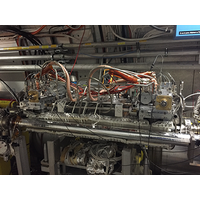在大型强子对撞机中使用导线进行束-束长程补偿的首个实验证据
IF 1.8
3区 物理与天体物理
Q3 PHYSICS, NUCLEAR
Physical Review Accelerators and Beams
Pub Date : 2024-07-23
DOI:10.1103/physrevaccelbeams.27.071003
引用次数: 0
摘要
在高强度和高能量对撞机中,如欧洲核子研究中心的大型强子对撞机(LHC)及其未来的高亮度升级版,围绕不同相互作用点的两束光之间的相互作用会对机器性能造成限制。事实上,它们会缩短光束的寿命,从而降低对撞机的光度。这些相互作用被称为光束-光束长程(BBLR)相互作用,而利用直流导线缓解其影响的可能性在 2000 年代初首次被提出。目前正在研究这一解决方案,将其作为提高 HL-LHC 性能的一种选择。2017 年和 2018 年,在大型强子对撞机中安装了四台线补偿器演示器。随后进行了长达两年的实验活动,以验证在大型强子对撞机中减缓 BBLR 相互作用的可能性。在这次活动中,完成了概念验证,并推动了一组额外的实验,成功证明了在与运行配置兼容的束流条件下减缓BBLR相互作用效应。本文详细报告了实验活动的准备情况,包括相应的跟踪模拟和获得的结果,并对未来提出了一些展望。本文章由计算机程序翻译,如有差异,请以英文原文为准。

First experimental evidence of a beam-beam long-range compensation using wires in the Large Hadron Collider
In high intensity and high energy colliders, such as the CERN Large Hadron Collider (LHC) and its future high-luminosity upgrade, interactions between the two beams around the different interaction points impose machine performance limitations. In fact, their effect reduces the beam lifetime, and therefore, the collider’s luminosity reach. Those interactions are called beam-beam long-range (BBLR) interactions, and a possible mitigation of their effect using dc wires was proposed for the first time in the early 2000’s. This solution is currently being studied as an option for enhancing the HL-LHC performance. In 2017 and 2018, four demonstrators of wire compensators have been installed in the LHC. A 2-yearlong experimental campaign followed in order to validate the possibility to mitigate the BBLR interactions in the LHC. During this campaign, a proof-of-concept was completed and motivated an additional set of experiments, successfully demonstrating the mitigation of BBLR interactions effects in beam conditions compatible with the operational configuration. This paper reports in detail the preparation of the experimental campaign, including the corresponding tracking simulations and the obtained results, and draws some perspectives for the future.
求助全文
通过发布文献求助,成功后即可免费获取论文全文。
去求助
来源期刊

Physical Review Accelerators and Beams
Physics and Astronomy-Surfaces and Interfaces
CiteScore
3.90
自引率
23.50%
发文量
158
审稿时长
23 weeks
期刊介绍:
Physical Review Special Topics - Accelerators and Beams (PRST-AB) is a peer-reviewed, purely electronic journal, distributed without charge to readers and funded by sponsors from national and international laboratories and other partners. The articles are published by the American Physical Society under the terms of the Creative Commons Attribution 3.0 License.
It covers the full range of accelerator science and technology; subsystem and component technologies; beam dynamics; accelerator applications; and design, operation, and improvement of accelerators used in science and industry. This includes accelerators for high-energy and nuclear physics, synchrotron-radiation production, spallation neutron sources, medical therapy, and intense-beam applications.
 求助内容:
求助内容: 应助结果提醒方式:
应助结果提醒方式:


